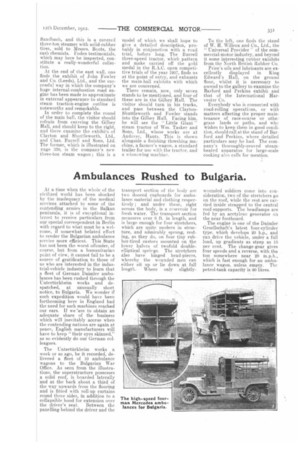Ambulances Rushed to Bulgaria.
Page 19

If you've noticed an error in this article please click here to report it so we can fix it.
At a. time when the whole of the civilized world has been shocked by the inadequacy of the medical services attached to some of the contending armies in the Balkan peninsula, it is of exceptional interef.t to receive particulars from our special correspondent in Berlin with regard to what must be a welcome, if somewhat belated effort to render the Bulgarian ambulance service more efficient. This State has not been the worst offender, of course, but from a humanitarian pGint of view, it cannot fail to be a source of gratification to those of us who are interested in the industrial-vehicle industry to learn that a fleet of German Daimler ambulances has been rushed through the Untertiirkheim works and despatched, at unusually short notice, to Bulgaria.. We wonder if such expedition would have been forthcoming here in England had the need for such machines reached our ears. If we 'are to obtain an adequate share of the business which will inevitably accrue when the contending nations are again at peace, English manufacturers will have to keep "their eyes skinned." as so evidently do our German colleagues.
The Untertiirkheim works a week or so ago, be it recorded, delivered a fleet of 10 ambulance wagons to the Bulgarian War Office. As seen from the illustrations, the superstructure possesses a solid roof, is boarded laterally and at the back about a third of the way upwards from the flooring and is fitted with roll-up curtains round three sides, in addition to a collapsible hood for extension over the driver's seat. Between the panelling behind the driver and the transport section of the body are two doored cupboards for ambulance material and clothing respectively ; and under these, right across the body, is a reservoir for fresh water. The transport section measures over 6 ft. in length, and is large enough for four stretchers, which are quite modern in structure, and admirably sprung, resting, as they do, on four tiny rubber-tired castors mounted on the lower halves of twofold double, elliptical spriegs. The stretchers also have hinged head-pieces, whereby the wounded men can either sit up or lie down at full length. Where only slightly wounded soldiers come into consideration, two of the stretchers go on the roof, while the rest are carried inside strapped to the central roof-supports. The headlamps are fed by an acetylene generator on the near footboard.
The engine is one of the Daimler Gesellschaft's latest four-cylinder type. which develops 20 h.p., and can drive the vehicle, under a full load, up gradients as steep as 10 per cent. The change-gear gives four speeds and a reverse, with the top somewhere near 20 m.p.h., which is fast enough for an ambulance wagon, unless empty. The petrol-tank capacity is 90 litres.
























